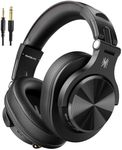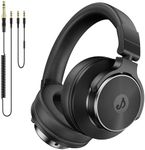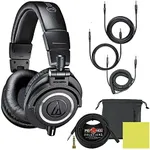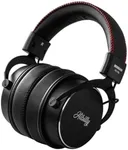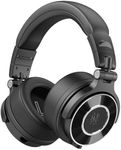Buying Guide for the Best Studio Monitor Headphones
Choosing the right studio monitor headphones is crucial for anyone involved in music production, mixing, or any audio-related work. These headphones are designed to provide a flat frequency response, allowing you to hear the audio exactly as it is, without any coloration. This helps in making accurate adjustments and decisions during the production process. To find the best fit for you, it's important to understand and evaluate several key specifications. Here’s a guide to help you navigate through the essential specs and make an informed decision.Frequency ResponseFrequency response refers to the range of frequencies that the headphones can reproduce. This is important because a wider frequency range allows you to hear more details in the audio. Typically, studio monitor headphones should cover at least 20 Hz to 20 kHz, which is the range of human hearing. If you are working with bass-heavy music, you might want headphones that can go lower than 20 Hz. Conversely, if you are focusing on vocals or high-frequency instruments, ensure the headphones can accurately reproduce higher frequencies.
ImpedanceImpedance is a measure of electrical resistance and is expressed in ohms. It affects how much power the headphones need to produce sound. Low impedance headphones (under 50 ohms) are suitable for use with portable devices like smartphones and laptops, as they require less power. High impedance headphones (over 50 ohms) are better suited for studio equipment with dedicated headphone amplifiers, as they can handle more power and often provide better sound quality. Choose based on your primary audio source: low impedance for portable use and high impedance for studio setups.
Driver SizeThe driver is the component that converts electrical signals into sound. Larger drivers (measured in millimeters) generally produce better bass and a more powerful sound. Common driver sizes for studio monitor headphones range from 40mm to 50mm. If you need precise bass response and a fuller sound, opt for headphones with larger drivers. However, for a more balanced and detailed sound, especially in the mid and high frequencies, driver size is less critical, and you can focus on other specs.
Closed-back vs. Open-backClosed-back headphones have a sealed design that isolates sound, preventing audio from leaking in or out. This is ideal for recording environments where you need to avoid bleed into microphones. Open-back headphones, on the other hand, have a perforated design that allows air and sound to pass through, providing a more natural and spacious sound. They are great for mixing and mastering but not suitable for recording. Choose closed-back for recording and open-back for mixing and mastering tasks.
Comfort and Build QualityComfort is crucial, especially if you will be wearing the headphones for extended periods. Look for headphones with adjustable headbands, cushioned ear pads, and lightweight designs. Build quality is also important for durability. Materials like metal and high-quality plastics are preferable. Try to find a balance between comfort and durability based on how long you will be using the headphones and how often you will be transporting them.
Cable Type and LengthThe type and length of the cable can affect your workflow. Coiled cables are flexible and can extend when needed, making them ideal for studio use where you might need to move around. Straight cables are less bulky and better for portable use. The length of the cable should be long enough to reach your audio source without causing tension but not so long that it becomes cumbersome. Consider your working environment and choose a cable type and length that suits your needs.
